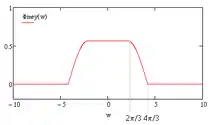Meyer wavelet
The Meyer wavelet is an orthogonal wavelet proposed by Yves Meyer.[1] As a type of a continuous wavelet, it has been applied in a number of cases, such as in adaptive filters,[2] fractal random fields,[3] and multi-fault classification.[4]

The Meyer wavelet is infinitely differentiable with infinite support and defined in frequency domain in terms of function as
where
There are many different ways for defining this auxiliary function, which yields variants of the Meyer wavelet. For instance, another standard implementation adopts

The Meyer scale function is given by
In the time domain, the waveform of the Meyer mother-wavelet has the shape as shown in the following figure:

Close expressions
Valenzuela and de Oliveira [5] give the explicit expressions of Meyer wavelet and scale functions:
and
where
References
- Meyer, Yves (1990). Ondelettes et opérateurs: Ondelettes. Hermann. ISBN 9782705661250.
- Xu, L.; Zhang, D.; Wang, K. (2005). "Wavelet-based cascaded adaptive filter for removing baseline drift in pulse waveforms". IEEE Transactions on Biomedical Engineering. 52 (11): 1973–1975. doi:10.1109/tbme.2005.856296. hdl:10397/193. PMID 16285403. S2CID 6897442.
- Elliott, Jr., F. W.; Horntrop, D. J.; Majda, A. J. (1997). "A Fourier-Wavelet Monte Carlo method for fractal random fields". Journal of Computational Physics. 132 (2): 384–408. Bibcode:1997JCoPh.132..384E. doi:10.1006/jcph.1996.5647.
- Abbasion, S.; et al. (2007). "Rolling element bearings multi-fault classification based on the wavelet denoising and support vector machine". Mechanical Systems and Signal Processing. 21 (7): 2933–2945. Bibcode:2007MSSP...21.2933A. doi:10.1016/j.ymssp.2007.02.003.
- Valenzuela, Victor Vermehren; de Oliveira, H. M. (2015). "Close expressions for Meyer Wavelet and Scale Function". Anais de XXXIII Simpósio Brasileiro de Telecomunicações. p. 4. arXiv:1502.00161. doi:10.14209/SBRT.2015.2. S2CID 88513986.
- Daubechies, Ingrid (September 1992). Ten Lectures on Wavelets (CBMS-NSF conference series in applied mathematics) (SIAM ed.). Springer-Verlag. pp. 117–119, 137–138, 152–155. ISBN 978-0-89871-274-2.